Key points
Global heating and climate change are a result of the enhanced greenhouse effect.
This is caused by an increase in the amount of greenhouse gases in the atmosphere and this reflects the emissions produced by humans.
These human causes of climate change are a result of two things:
- growing world population - more people need more food, shelter, energy, products and services to live
- economic developments - the way people live and the industries that support this use more energy, land and resources
Between 1850 and 2021, the amount of carbon dioxide in the atmosphere has risen by 48%. This coincides with huge increases in industrialisation which involved a similar increase in the burning of fossil fuels.
Fossil fuels remain the main source of human carbon emissions. Analysing data means that all the major human causes of climate change can be measured, which can help us plan how best to reduce the impact we are having on global temperatures.
Energy
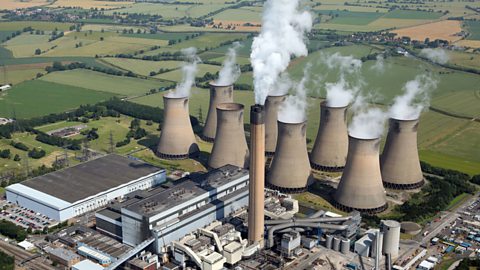
By far the biggest human cause of greenhouse gas emissions is energy production.
Most of our energy comes directly or indirectly from the burning of fossil fuels.
- Fossil fuels are burned to generate electricity at power stations.
- Some industries burn fossil fuels directly as sources of energy.
- Fossil fuels are burned to heat buildings. In the UK this is mostly the use of gas for central heating.
- Petrol, diesel and other products from oil are the main energy source for transport.
In 2016, 73.2% of global greenhouse gas emissions came from energy. This was related to the following uses:
| Sector | Proportion of global greenhouse gas emissions |
|---|---|
| Energy (total) | 73.2% |
| Energy use in industry | 24.2% |
| Energy use in buildings | 17.5% |
| Transport | 16.2% |

Energy use in industry
The energy used by industry produces nearly one quarter of all human greenhouse gas emissions.
In 2016, 24.2% of global greenhouse gas emissions came from energy used in industry:
| Sector | Proportion of global greenhouse gas emissions |
|---|---|
| Energy used in industry (total) | 24.2% |
| Iron and steel | 7.2% |
| Chemical and petrochemical | 3.6% |
| Food and tobacco | 1% |
| Other industry | 10.6% |
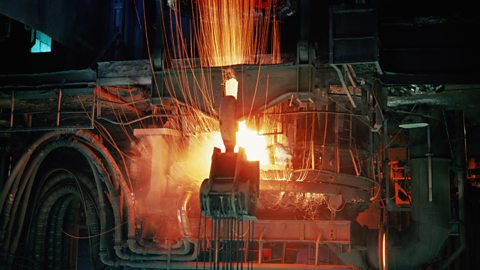
Iron and steel production involves burning coal to produce heat and to add carbon to the metal, which makes it stronger.
Chemical and petrochemical industries need energy to make products including plastics and fertilisers.
Turning raw ingredients into food products requires energy for processes like heating and cooking, cooling and freezing, drying, grinding, mixing and moving ingredients around factories.
The other industries that are responsible for 10.6% of emissions include extraction industries like mining and quarrying, manufacturing wood and textile products, and construction.

Energy use in buildings
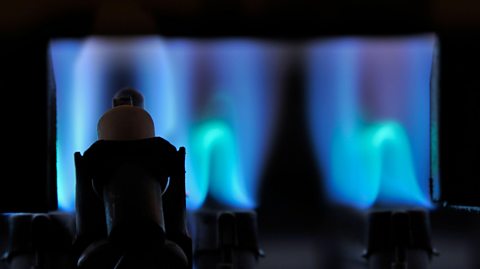
The buildings where we live, learn, work and relax all use energy.
Think about the electricity you use at home. You need this for lighting, TV, gaming, and charging phones and tablets. Electricity produces heat to boil the kettle or to dry your hair. It is used to cool the fridge and freezer.
School, cafes, shops, offices, hospitals, cinemas, sports centres - all need electricity too.
Most homes in the UK are heated using natural gas. Whatever the source of heat, a large amount of this energy is lost as wasted heat when buildings are draughty and badly insulated.
In 2016, 17.5% of global greenhouse gas emissions came from energy used in buildings:
| Sector | Proportion of global greenhouse gas emissions |
|---|---|
| Energy used in buildings (total) | 17.5% |
| Residential (homes) | 10.9% |
| Commercial | 6.6% |

Transport
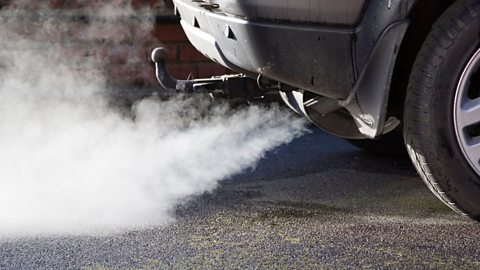
In 2016, 16.2% of global greenhouse gas emissions came from transport.
Transport doesn't just mean how people get around. It includes the movement of any products too.
The distance someone or something travels, and the method of transport can both have a big effect on the carbon emitted.
| Sector | Proportion of global greenhouse gas emissions |
|---|---|
| Transport (total) | 16.2% |
| Road | 11.2% |
| Aviation | 1.9% |
| Shipping | 1.7% |
| Rail | 0.4% |


Many products are transported around the world in global supply chains:
Raw materials need to be transported from where they are found to where they are processed. For example, wheat is transported from a farm to a factory.
Products are transported from where they are made to where they are sold. For example, breakfast cereal is transported from a factory to a shop or supermarket. It might even have two journeys - first to a distribution centre, and then from there to a shop.
When we buy something it has to be transport it to our home. For example, you might travel by car to and from the supermarket to buy cereal and other groceries. Or your family might order groceries online that are delivered by van.

Agriculture, forestry and land use
In 2016, 18.4% of global greenhouse gas emissions came from agriculture, forestry and other land use. This was related to the following uses:
| Sector | Proportion of global greenhouse gas emissions |
|---|---|
| Agriculture, forestry and land use (total) | 18.4% |
| Livestock and manure | 5.8% |
| Use of chemical fertilisers | 4.1% |
| Crop burning | 3.5% |
| Deforestation | 2.2% |
| Rice production | 1.3% |

Livestock produces carbon emissions in the form of methane. When cows and sheep eat, microbes in their digestive systems break the food down, producing methane that is released at either end of the animal. If you added the carbon emissions from producing food for livestock, this figure would be higher.
When manure builds up or is stored in conditions with little oxygen, the greenhouse gases methane and nitrous oxide are produces as it decomposes. Using synthetic chemical fertilisers also releases nitrous oxide.
Burning waste from crops causes air pollution that is a health hazard as well as contributing to global warming. Processing this waste into fuel or fertiliser can dramatically reduce this pollution.
Rice is grown in flooded paddy fields in which bacteria that release methane thrive. In some places, alternately flooding and then leaving fields to dry could reduce methane production.

Industry
In 2016, 5.2% of global greenhouse gas emissions came directly from industry. This doesn't include the energy used in industry but means greenhouse gases that are produced directly from industrial processes.
These emissions were related to the following uses:
| Sector | Proportion of global greenhouse gas emissions |
|---|---|
| Industry (total) | 5.2% |
| Cement | 3% |
| Chemicals and petrochemicals | 2.2% |

Cement is largely made from limestone which is ground up and heated. When this happens a chemical reaction emits carbon dioxide:
calcium carbonate → calcium oxide + carbon dioxide
CaCO3(s) → CaO(s) + CO2(g)Carbon dioxide is also emitted during the production of materials including plastics, synthetic textiles and fertilisers.

Waste
In 2016, 3.2% of global greenhouse gas emissions came directly from waste. Just because we have finished with something doesn't mean that it stops producing greenhouse gases.
These emissions were related to the following uses:
| Sector | Proportion of global greenhouse gas emissions |
|---|---|
| Waste (total) | 3.2% |
| Landfill | 1.9% |
| Waste water | 1.3% |
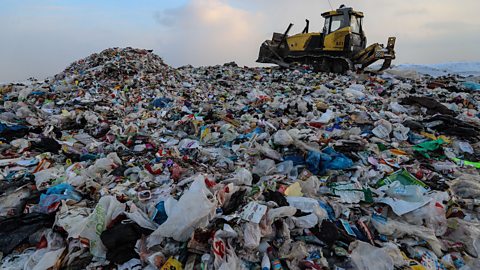
Landfill sites are where the waste we produce that is not recycled ends up. Waste is piled up and crammed together, with very little air around it. In these conditions organic waste, for example from food scraps, produces methane when it decomposes.
Wastewater includes human waste that goes down the toilet or sink, as well as water from industry and farming. Carbon dioxide, nitrous oxide and methane are all emitted byorganic wasteand throughwater treatment*.

Test your knowledge
Quiz
About this data
There are many different ways to break down sources of carbon emissions. The figures we have used treat energy as a specific source, so the other figures would be higher if you included the energy used to make them happen.
For example, the carbon emissions for concrete production don't include the energy used to extract raw materials, run factories or for transport.
Figures come from 2016 and are based on this source:
Hannah Ritchie and Max Roser (2020) - "COâ‚‚ and Greenhouse Gas Emissions". Published online at . Retrieved from: '' [Online Resource]
More on Climate change
Find out more by working through a topic
- count1 of 3
